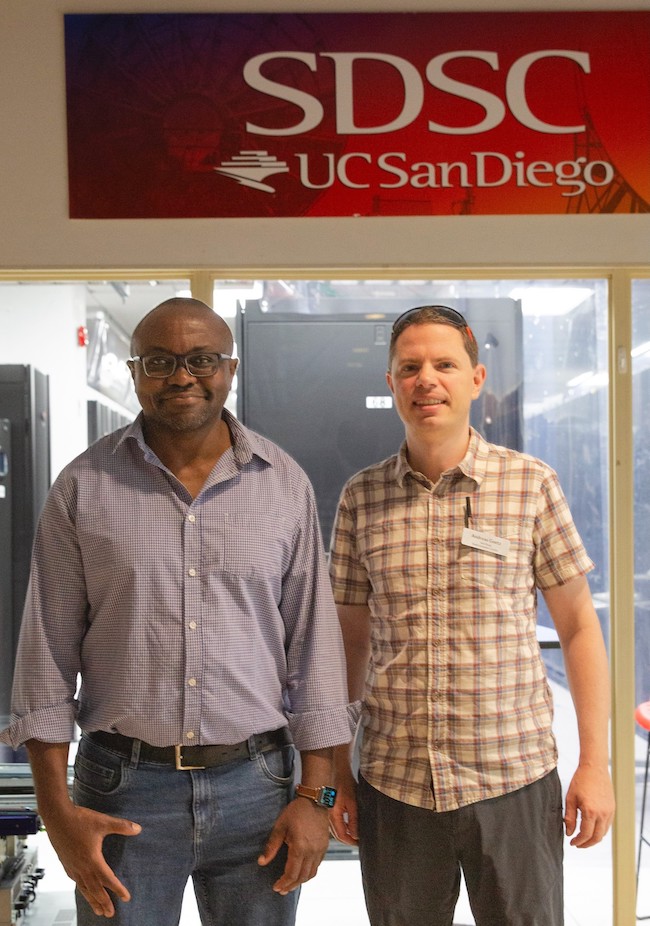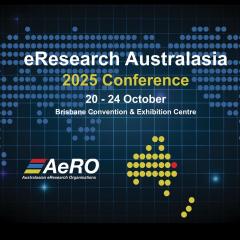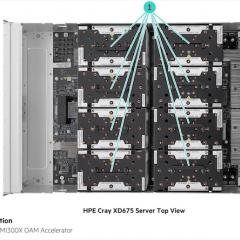Before University of Queensland computational chemistry researcher Dr Paul Visendi Muhindira attended a RCC seminar last August, he had no idea it would inspire him to visit San Diego in the USA.
But it wasn’t the Californian climate or famous San Diego Zoo that inspired Dr Muhindira’s trip. After San Diego Supercomputer Center (SDSC) Director Professor Frank Würthwein mentioned during his in-person seminar at RCC that SDSC had more than 3,000 GPUs and a strong research history in computational simulations, Dr Muhindira knew he had to visit.
“I was pleased to know that the developers of the Amber simulation engine [Amber is a suite of biomolecular simulation programs], which I use for my research, are based at the SDSC. I had to reach out!” said Dr Muhindira, a Senior Research Officer and Postdoctoral Fellow in the Craik Group at UQ’s Centre for Chemistry and Drug Discovery, Institute for Molecular Bioscience (IMB).
Dr Muhindira, whose research involves target (gene) discovery and peptide design in the initial stages of drug development, wanted to explore the application of cutting-edge Free Energy (FE) simulation methods within Amber for drug design. Free energy simulations precisely predict how strongly a drug molecule binds to its biological target. They are highly accurate because they model detailed physical interactions at the atomic level, helping researchers efficiently identify effective drug candidates before laboratory testing.
“SDSC is a hub for advanced computational chemistry, and its scientists actively contribute to developing and maintaining the Amber simulation source code. This visit allowed me to engage directly with experts advancing FE methods, test these approaches on SDSC’s GPUs on the Expanse supercomputer, and explore new ways to apply them to peptide drug design and enzyme engineering.
“I learned about the latest FE methods, which are crucial for drug design due to their higher accuracy in evaluating molecular interactions compared to Molecular Mechanics (MM) methods. FE methods are computationally more demanding, but I have [UQ supercomputer] Bunya for that. I will apply these techniques to more accurately assess and select peptide drug candidates and to engineer more efficient enzymes.”
At SDSC, Dr Muhindira established a collaboration with Prof. Andreas Goetz, the director of SDSC’s Computational Chemistry Laboratory and an expert in molecular dynamics and quantum chemistry simulations.
“He has significantly contributed to the Amber code, which I use in my research. I hope to expand my capabilities in Amber and to contribute to the development of new Amber methods through this collaboration, particularly for peptide drug design. His experience optimising code for multiple GPU cores and architectures will be invaluable for advancing my research and knowledge,” said Dr Muhindira.
“Additionally, I connected with other key Amber developers [at SDSC], which opened opportunities for future collaborations on Amber methods.”
Dr Muhindira uses Amber daily for his research via UQ supercomputer Bunya. Upon Dr Muhindira’s request, RCC’s Policy and Liaison Manager Dr Marlies Hankel installed Amber on Bunya for him and other UQ researchers to use.
Dr Muhindira runs Amber code on multi-instance GPUs on Bunya to identify new genes that drive disease conditions, and design peptides that can be used to treat those conditions. Diseases he works on include chronic pain and Restless Leg Syndrome (RLS), in addition to mining novel enzymes responsible for theta defensin biosynthesis (mammalian antimicrobial peptides), found in non-human primates. Theta defensins confer immunity to HIV and other microbes and are potential anti-viral and antimicrobial drugs.
“Both Bunya and Amber are essential for my day-to-day research. Amber provides a robust and accurate simulation engine, enabling me to model various drug designs and simulate their effect using molecular dynamics. Simulating designs allows me to evaluate possible interactions a drug design will likely have on a target. With this knowledge, I can prioritise the most promising designs for synthesis and experimental validation. This significantly reduces the time and resources that would be taken up by extensive experimental validation of non-significant designs.
“Bunya provides high-end computational resources, enabling me to set up and run complex simulations quickly. Bunya's computational resources are critical for scaling Amber simulations to the necessary size and numbers. Without Bunya, running these simulations on standard workstations would not be feasible, making it almost impossible to conduct enough simulations in a reasonable time.”
Dr Muhindira’s research aims to design peptide drug candidates that could ultimately progress into the clinic and also be synthesised in plants, an innovative approach inspired by the vision of UQ Professor David Craik, Director of the ARC Centre of Excellence for Innovations in Peptide and Protein Science (CIPPS) at IMB.
“Plant-based production of peptide drugs has several significant societal benefits: it can dramatically reduce the cost of drug production by eliminating the need for complex chemical synthesis processes,” said Dr Muhindira. “This method also minimises the environmental impact of chemical waste typically associated with traditional pharmaceutical manufacturing. By making the process more sustainable and cost-effective, we can increase the accessibility of life-saving drugs, particularly in developing countries, where affordability and access to essential medications is a challenge. The Covid pandemic highlighted this.”
Dr Muhindira’s visit to SDSC was funded by CIPPS.
“I would like to thank Prof. Craik and CIPPS for the opportunity to contribute to peptide drug development and for the funding for my visit to SDSC. Prof. Andreas Goetz and the Amber developer team at SDSC for their time, and RCC for the exceptional HPC resources and Dr Marlies Hankel’s technical support on Bunya,” said Dr Muhindira.

UQ's Dr Paul Visendi Muhindira with Prof. Andreas Goetz, the director of SDSC’s Computational Chemistry Laboratory.



